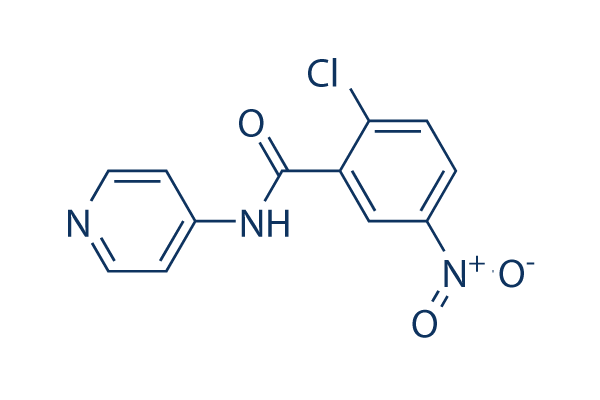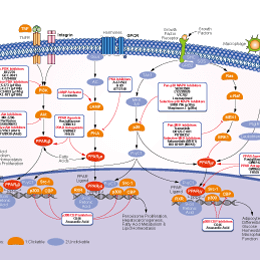
- Bioactive Compounds
- By Signaling Pathways
- PI3K/Akt/mTOR
- Epigenetics
- Methylation
- Immunology & Inflammation
- Protein Tyrosine Kinase
- Angiogenesis
- Apoptosis
- Autophagy
- ER stress & UPR
- JAK/STAT
- MAPK
- Cytoskeletal Signaling
- Cell Cycle
- TGF-beta/Smad
- DNA Damage/DNA Repair
- Compound Libraries
- Popular Compound Libraries
- Customize Library
- Clinical and FDA-approved Related
- Bioactive Compound Libraries
- Inhibitor Related
- Natural Product Related
- Metabolism Related
- Cell Death Related
- By Signaling Pathway
- By Disease
- Anti-infection and Antiviral Related
- Neuronal and Immunology Related
- Fragment and Covalent Related
- FDA-approved Drug Library
- FDA-approved & Passed Phase I Drug Library
- Preclinical/Clinical Compound Library
- Bioactive Compound Library-I
- Bioactive Compound Library-Ⅱ
- Kinase Inhibitor Library
- Express-Pick Library
- Natural Product Library
- Human Endogenous Metabolite Compound Library
- Alkaloid Compound LibraryNew
- Angiogenesis Related compound Library
- Anti-Aging Compound Library
- Anti-alzheimer Disease Compound Library
- Antibiotics compound Library
- Anti-cancer Compound Library
- Anti-cancer Compound Library-Ⅱ
- Anti-cancer Metabolism Compound Library
- Anti-Cardiovascular Disease Compound Library
- Anti-diabetic Compound Library
- Anti-infection Compound Library
- Antioxidant Compound Library
- Anti-parasitic Compound Library
- Antiviral Compound Library
- Apoptosis Compound Library
- Autophagy Compound Library
- Calcium Channel Blocker LibraryNew
- Cambridge Cancer Compound Library
- Carbohydrate Metabolism Compound LibraryNew
- Cell Cycle compound library
- CNS-Penetrant Compound Library
- Covalent Inhibitor Library
- Cytokine Inhibitor LibraryNew
- Cytoskeletal Signaling Pathway Compound Library
- DNA Damage/DNA Repair compound Library
- Drug-like Compound Library
- Endoplasmic Reticulum Stress Compound Library
- Epigenetics Compound Library
- Exosome Secretion Related Compound LibraryNew
- FDA-approved Anticancer Drug LibraryNew
- Ferroptosis Compound Library
- Flavonoid Compound Library
- Fragment Library
- Glutamine Metabolism Compound Library
- Glycolysis Compound Library
- GPCR Compound Library
- Gut Microbial Metabolite Library
- HIF-1 Signaling Pathway Compound Library
- Highly Selective Inhibitor Library
- Histone modification compound library
- HTS Library for Drug Discovery
- Human Hormone Related Compound LibraryNew
- Human Transcription Factor Compound LibraryNew
- Immunology/Inflammation Compound Library
- Inhibitor Library
- Ion Channel Ligand Library
- JAK/STAT compound library
- Lipid Metabolism Compound LibraryNew
- Macrocyclic Compound Library
- MAPK Inhibitor Library
- Medicine Food Homology Compound Library
- Metabolism Compound Library
- Methylation Compound Library
- Mouse Metabolite Compound LibraryNew
- Natural Organic Compound Library
- Neuronal Signaling Compound Library
- NF-κB Signaling Compound Library
- Nucleoside Analogue Library
- Obesity Compound Library
- Oxidative Stress Compound LibraryNew
- Plant Extract Library
- Phenotypic Screening Library
- PI3K/Akt Inhibitor Library
- Protease Inhibitor Library
- Protein-protein Interaction Inhibitor Library
- Pyroptosis Compound Library
- Small Molecule Immuno-Oncology Compound Library
- Mitochondria-Targeted Compound LibraryNew
- Stem Cell Differentiation Compound LibraryNew
- Stem Cell Signaling Compound Library
- Natural Phenol Compound LibraryNew
- Natural Terpenoid Compound LibraryNew
- TGF-beta/Smad compound library
- Traditional Chinese Medicine Library
- Tyrosine Kinase Inhibitor Library
- Ubiquitination Compound Library
-
Cherry Picking
You can personalize your library with chemicals from within Selleck's inventory. Build the right library for your research endeavors by choosing from compounds in all of our available libraries.
Please contact us at info@selleckchem.com to customize your library.
You could select:
- Antibodies
- Bioreagents
- qPCR
- 2x SYBR Green qPCR Master Mix
- 2x SYBR Green qPCR Master Mix(Low ROX)
- 2x SYBR Green qPCR Master Mix(High ROX)
- Protein Assay
- Protein A/G Magnetic Beads for IP
- Anti-Flag magnetic beads
- Anti-Flag Affinity Gel
- Anti-Myc magnetic beads
- Anti-HA magnetic beads
- Poly DYKDDDDK Tag Peptide lyophilized powder
- Protease Inhibitor Cocktail
- Protease Inhibitor Cocktail (EDTA-Free, 100X in DMSO)
- Phosphatase Inhibitor Cocktail (2 Tubes, 100X)
- Cell Biology
- Cell Counting Kit-8 (CCK-8)
- Animal Experiment
- Mouse Direct PCR Kit (For Genotyping)
- New Products
- Contact Us
T0070907
Home DNA Damage/DNA Repair PPAR inhibitor - DNA-PK inhibitor - RAD51 inhibitor T0070907
For research use only.
T0070907 is a potent inhibitor of PPARγ (peroxisome proliferator activator receptor γ ) that induces G2/M arrest and enhances the effect of radiation in human cervical cancer cells through mitotic catastrophe. It also acts as an antagonist of PPARγ that suppresses breast cancer cell proliferation and motility via both PPARgamma-dependent and -independent mechanisms.

T0070907 Chemical Structure
CAS No. 313516-66-4
Purity & Quality Control
Batch:
Purity:
99.96%
99.96
T0070907 Related Products
| Related Targets | PPARα PPARβ/δ PPARγ PPARδ | Click to Expand |
|---|---|---|
| Related Products | GW9662 GW6471 WY-14643 (Pirinixic Acid) GSK3787 GW0742 AZ6102 Astaxanthin Eupatilin GSK0660 Palmitoylethanolamide Harmine Oroxin A Clofibric Acid Daidzein Ciprofibrate Elafibranor Glabridin Alpinetin Lanifibranor (IVA-337) Gypenoside XLIX DG172 dihydrochloride | Click to Expand |
| Related Compound Libraries | FDA-approved Drug Library Natural Product Library Apoptosis Compound Library DNA Damage/DNA Repair compound Library Cell Cycle compound library | Click to Expand |
Signaling Pathway
Cell Data
| Cell Lines | Assay Type | Concentration | Incubation Time | Formulation | Activity Description | PMID |
|---|---|---|---|---|---|---|
| OR6 | Cytotoxicity assay | 72 hrs | Cytotoxicity against african green monkey OR6 cells after 72 hrs by WST1 assay, CC50=2.7μM. | 23891183 | ||
| OR6 | Antiviral assay | 72 hrs | Antiviral activity against HCV infected in african green monkey OR6 cells assessed as inhibition of viral RNA replication after 72 hrs by luciferase reporter gene assay, ED50=4.9μM. | 23891183 | ||
| Click to View More Cell Line Experimental Data | ||||||
Biological Activity
| Description | T0070907 is a potent inhibitor of PPARγ (peroxisome proliferator activator receptor γ ) that induces G2/M arrest and enhances the effect of radiation in human cervical cancer cells through mitotic catastrophe. It also acts as an antagonist of PPARγ that suppresses breast cancer cell proliferation and motility via both PPARgamma-dependent and -independent mechanisms. | |
|---|---|---|
| Targets |
|
| In vitro | ||||
| In vitro | T0070907 is a potent and selective PPARγ antagonist. With an apparent binding affinity of 1 nM, T0070907 covalently modifies PPARγ on cysteine 313 in helix 3 of human PPARγ2. T0070907 blocks PPARγ function in both cell-based reporter gene and adipocyte differentiation assays. Consistent with its role as an antagonist of PPARγ, T0070907 blocks agonist-induced recruitment of coactivator-derived peptides to PPARγ in a homogeneous time-resolved fluorescence-based assay and promotes recruitment of the transcriptional corepressor NCoR to PPARγ in both glutathione S-transferase pull-down assays and a PPARγ/retinoid X receptor (RXR) α-dependent gel shift assay. Studies with mutant receptors suggest that T0070907 modulates the interaction of PPARγ with these cofactor proteins by affecting the conformation of helix 12 of the PPARγ ligand-binding domain. Interestingly, whereas the T0070907-induced NCoR recruitment to PPARγ/RXRα heterodimer can be almost completely reversed by the simultaneous treatment with RXRα agonist LGD1069, T0070907 treatment has only modest effects on LGD1069-induced coactivator recruitment to the PPARγ/RXRα heterodimer. [1] T0070907 treatment inhibits proliferation, invasion and migration but does not significantly affect apoptosis. Molecular inhibition using a dominant negative (Δ462) receptor yields similar results. T007 also mediates a dose-dependent decrease in phosphorylation of PPARγ, and its ability to bind to DNA, and may directly affect mitogen-activated protein kinase signaling. [2] |
|||
|---|---|---|---|---|
| Kinase Assay | Ligand Binding Assay | |||
| To determine the binding affinity of T0070907 to the PPARs, scintillation proximity assay (SPA) is performed with the following modifications. A 90-μl reaction contains SPA buffer (10 mm KH2PO4, 10 mm KH2PO4, 2 mm EDTA, 50 mm NaCl, 1 mm dithiothreitol, 2 mmCHAPS, 10% (v/v) glycerol, pH 7.1), 50 ng of GST-PPARγ (or 150 ng of GST-PPARα, GST-PPARδ), 5 nm 3H-labeled radioligands, and 5 μl of T0070907 in Me2SO. After incubation for 1 h at room temperature, 10 μl of polylysine-coated SPA beads (at 20 mg/ml in SPA buffer) are added, and the mixtureis incubated for 1 h before reading in Packard Topcount. | ||||
| Cell Research | Cell lines | MCF-7 cells | ||
| Concentrations | 20 μM and higher concentrations | |||
| Incubation Time | 48 h | |||
| Method | MTS assay |
|||
| In Vivo | ||
| In vivo | Lipopolysaccharide preconditioning significantly attenuates the development of renal dysfunction, hepatocellular injury, and circulatory failure as well as the increase in the plasma levels of interleukin-1 [beta] caused by severe endotoxemia. T0070907 can attenuate all of these beneficial effects afforded by preconditioning with lipopolysaccharide [3] |
|
|---|---|---|
| Animal Research | Animal Models | Preconditioning is performed by administering a low dose (1 mg/kg) of Escherichia coli LPS (serotype 0.127:B8) intraperitoneally 24 hr before the induction of severe endotoxemia. |
| Dosages | 1 mg/kg | |
| Administration | intraperitoneally | |
|
Chemical Information & Solubility
| Molecular Weight | 277.66 | Formula | C12H8ClN3O3 |
| CAS No. | 313516-66-4 | SDF | Download T0070907 SDF |
| Smiles | C1=CC(=C(C=C1[N+](=O)[O-])C(=O)NC2=CC=NC=C2)Cl | ||
| Storage (From the date of receipt) | |||
|
In vitro |
DMSO : 55 mg/mL ( (198.08 mM) Moisture-absorbing DMSO reduces solubility. Please use fresh DMSO.) Water : Insoluble Ethanol : Insoluble |
Molecular Weight Calculator |
|
In vivo Add solvents to the product individually and in order. |
In vivo Formulation Calculator |
|||||
Preparing Stock Solutions
Molarity Calculator
In vivo Formulation Calculator (Clear solution)
Step 1: Enter information below (Recommended: An additional animal making an allowance for loss during the experiment)
mg/kg
g
μL
Step 2: Enter the in vivo formulation (This is only the calculator, not formulation. Please contact us first if there is no in vivo formulation at the solubility Section.)
% DMSO
%
% Tween 80
% ddH2O
%DMSO
%
Calculation results:
Working concentration: mg/ml;
Method for preparing DMSO master liquid: mg drug pre-dissolved in μL DMSO ( Master liquid concentration mg/mL, Please contact us first if the concentration exceeds the DMSO solubility of the batch of drug. )
Method for preparing in vivo formulation: Take μL DMSO master liquid, next addμL PEG300, mix and clarify, next addμL Tween 80, mix and clarify, next add μL ddH2O, mix and clarify.
Method for preparing in vivo formulation: Take μL DMSO master liquid, next add μL Corn oil, mix and clarify.
Note: 1. Please make sure the liquid is clear before adding the next solvent.
2. Be sure to add the solvent(s) in order. You must ensure that the solution obtained, in the previous addition, is a clear solution before proceeding to add the next solvent. Physical methods such
as vortex, ultrasound or hot water bath can be used to aid dissolving.
Tech Support
Answers to questions you may have can be found in the inhibitor handling instructions. Topics include how to prepare stock solutions, how to store inhibitors, and issues that need special attention for cell-based assays and animal experiments.
Tel: +1-832-582-8158 Ext:3
If you have any other enquiries, please leave a message.
* Indicates a Required Field






































